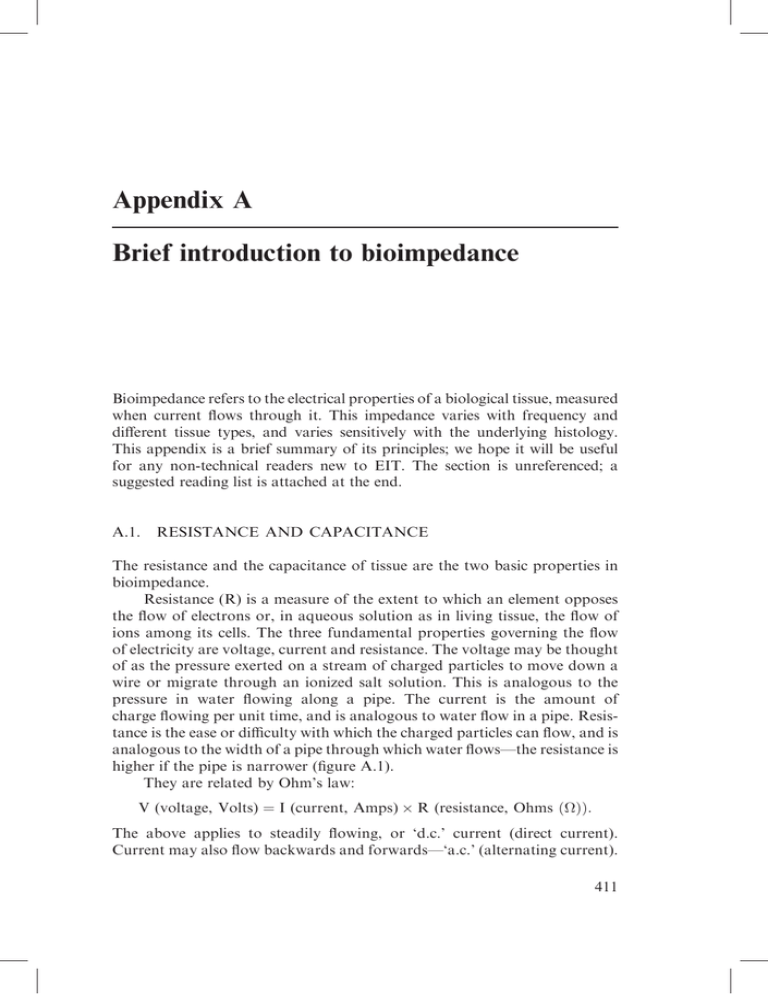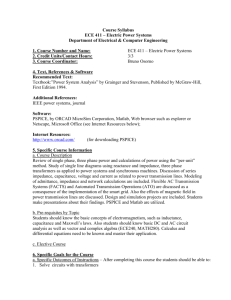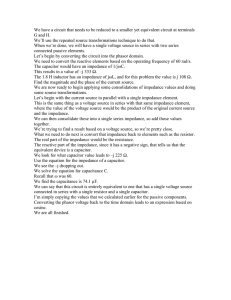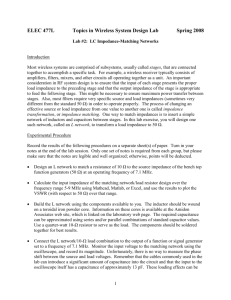Appendix A Brief introduction to bioimpedance
advertisement

Appendix A Brief introduction to bioimpedance Bioimpedance refers to the electrical properties of a biological tissue, measured when current flows through it. This impedance varies with frequency and different tissue types, and varies sensitively with the underlying histology. This appendix is a brief summary of its principles; we hope it will be useful for any non-technical readers new to EIT. The section is unreferenced; a suggested reading list is attached at the end. A.1. RESISTANCE AND CAPACITANCE The resistance and the capacitance of tissue are the two basic properties in bioimpedance. Resistance (R) is a measure of the extent to which an element opposes the flow of electrons or, in aqueous solution as in living tissue, the flow of ions among its cells. The three fundamental properties governing the flow of electricity are voltage, current and resistance. The voltage may be thought of as the pressure exerted on a stream of charged particles to move down a wire or migrate through an ionized salt solution. This is analogous to the pressure in water flowing along a pipe. The current is the amount of charge flowing per unit time, and is analogous to water flow in a pipe. Resistance is the ease or difficulty with which the charged particles can flow, and is analogous to the width of a pipe through which water flows—the resistance is higher if the pipe is narrower (figure A.1). They are related by Ohm’s law: V (voltage, Volts) ¼ I (current, Amps) R (resistance, Ohms ð ÞÞ: The above applies to steadily flowing, or ‘d.c.’ current (direct current). Current may also flow backwards and forwards—‘a.c.’ (alternating current). 411 412 Brief introduction to bioimpedance Figure A.1. Basic concepts—current, voltage and resistance. Analogy to water flow. Resistance has the same effect on a.c. current as d.c. current. Capacitance (C) is an expression of the extent to which an electronic component, circuit or system, stores and releases energy as the current and voltage fluctuate with each a.c. cycle. The capacitance physically corresponds to the ability of plates in a capacitor to store charge. With each cycle, charges accumulate and then discharge. Direct current cannot pass through a capacitor. A.c. can pass because of the rapidly reversing flux of charge. The capacitance is an unvarying property of a capacitive or more complex circuit. However, the effect in terms of the ease of current passage depends on the frequency of the applied current—charges pass backwards and forwards more rapidly if the applied frequency is higher. For the purposes of bioimpedance, a useful concept for current travelling through a capacitance is ‘reactance’ (X). The reactance is analogous to resistance—a higher reactance has a higher effective resistance to alternating current. Like resistance, its value is in Ohms, but it depends on the applied frequency, which should be specified (figure A.2). The relationship is Reactance (Ohms) ¼ 1=ð2 Frequency ðHzÞ Capacitance ðFaradsÞÞ: When a current is passing through a purely resistive circuit, the voltage recorded across the resistor will coincide exactly with the timing, or phase, of the applied alternating current, as one would expect. In the water flow analogy, an increase in pressure across a narrowing will be instantly followed by an increase in flow. When current flows across a capacitor, the voltage recorded across it lags behind the applied current. This is because the back and forth flow of current depends on repeated charging and discharging of the plates of the capacitor. This takes a little time to develop. To pursue the water analogy, a capacitor would be equivalent to a taut membrane stretched Resistance and capacitance Figure A.2. 413 Capacitance, reactance and effect of frequency. across the pipe. No continuous flow could pass. However, if the flow is constantly reversed, then for each new direction, a little water will flow as the membrane bulges, and then flow back the other way when the flow reverses. The development of pressure on the membrane will only build up after some water has flowed into the membrane to stretch it. In terms of a sine wave which has 3608 in a full cycle, the lag is one quarter of a cycle, or 908. In practice, this is seen if an oscilloscope is set up as in figure A.3. An ideal (confused with d.c.) current a.c. source passes current across a resistor or capacitor. The current delivered by the source is displayed on the upper trace. The voltage measured over the components is displayed on the lower trace. When this is across a resistor, it is in phase—when across a capacitor, it lags by 908 and is said to be ‘out-of-phase’. When the circuit contains a mixture of resistance and capacitance, the phase is intermediate between 0 and 908, and depends on the relative contributions from resistance and capacitance. As a constant current is applied, the total combination of resistance or reactance, the impedance can be calculated by Ohm’s law from the amplitude of the voltage at the peak of the sine wave. 414 Brief introduction to bioimpedance Figure A.3. The voltage that results from an applied current is in phase for a resistor (A) and 908 out of phase for a capacitor. Impedance is made of these two components, resistance or the real part of the data, and reactance, the out-of-phase data. These are usually displayed on a graph in which resistance is the x axis and reactance is the y axis. This is termed the ‘complex’ impedance, and the graph is the ‘complex’ plane. For mathematical reasons to do with solutions of the equations for the sine waves of the a.c. voltages, the in-phase resistive component is considered to be a ‘real’ or normal number. The out-of-phase, capacitative, component is considered to be ‘imaginary’. This means that the amplitude of the capacitative voltage, a real number such as 3.2 V, is multiplied by ‘j’, which is the square root of minus 1. Thus, a typical complex impedance might be written as 450 þ 370j : This would mean that the resistance is 450 and the reactance is 370 , and would be displayed on the complex plane as in figure A.4, with the resistance on the x axis and reactance on the y axis. Another equivalent way is to calculate the length of the impedance line, which passes from the origin of the graph to the complex impedance point. This is termed the ‘modulus’ of the impedance (Z), and means its total amplitude, irrespective of whether 415 Figure A.4. Resistance and capacitance 416 Brief introduction to bioimpedance it is resistance or reactance. In practice, this is identical to the amplitude of the sine wave of measured voltage, seen on an oscilloscope, as in figure A.3, irrespective of the phase angle. The ‘phase angle’ is calculated from the graph, and is given along with the modulus. The phase angle on the graph is exactly the same as the lag in phase of the measured voltage (figure A.4). For the above example, 450 þ 370j ðR þ jXÞ converts to 583 at 398ðZ þ Þ: A.2. IMPEDANCE IN BIOLOGICAL TISSUE Cells may be modelled as a group of electronic components. One of the simplest employs just three components (figure A.5). The extracellular space is represented as a resistor (Re), and the intracellular space and the membrane is modelled as a resistor (Ri) and a capacitor (Cm) (figure A.5(a)). Both the extracellular space and intracellular space are highly conductive, because they contain salt ions. The lipid membrane of cells is an insulator, which prevents current at low frequencies from entering the cells. At lower frequencies, almost all the current flows through the extracellular space only, so the total impedance is largely resistive and is equivalent to that of the extracellular space. As this is usually about 20% or less of the total tissue, the resulting impedance is relatively high. At higher frequencies, the current can cross the capacitance of the cell membrane and so enter the intracellular space as well. It then has access to the conductive ions in both the extra- and intra-cellular spaces, so the overall impedance is lower (figure A.6(a)). Figure A.5. (a) The cell modelled as basic electronic circuit. Ri and Re are the resistances of the intracellular- and extracellular-space, and Cm is the membrane capacitance. (b) Cole–Cole plot of this circuit. Impedance in biological tissue 417 Figure A.6. (a) The movement of current through cells at both low and high frequencies. (b) Idealized Cole–Cole plot for tissue. The movement of the current in the different compartments of the cellular spaces at different frequencies, and the related resistance and reactance values measured, is usefully displayed as a Cole–Cole plot. This is an extension of the resistance/reactance plot in the complex plane. Instead of the single point for a measurement at one frequency, as in figure A.4, the values for a range of frequencies are all superimposed. For simple electronic components, the arc will be a semicircle (figure A.5(b)). At low frequencies, the measurement is only resistive, and corresponds to the extracellular resistance—no current passes through the intracellular path because it cannot cross the cell membrane capacitance. As the applied frequency increases, the phase angle gradually increases as more current is diverted away from the extracellular resistance, and passes through the capacitance of the intracellular route. At high frequencies, the intracellular capacitance becomes negligible, so current enters the parallel resistances of the intracellular and extracellular compartments. The cell membrane reactance is now nil, so the entire impedance again is just resistive and so returns to the X axis. Between these, the current passing through the capacitative path reaches a peak. The frequency at which this 418 Brief introduction to bioimpedance occurs is known as the centre frequency (Fc), and is a useful measure of the properties of an impedance. In real tissue, the Cole–Cole plot is not exactly semicircular, because the detailed situation is clearly much more complex; the plot is usually approximately semicircular, but the centre of the circle lies below the x-axis. Inspection of the Cole–Cole plot yields the high- and low-frequency resistances, as the intercept with the x-axis, and the centre frequency is the point at which the phase angle is greatest. The angle of depression of the centre of the semicircle is another means of characterizing the tissue (figure A.6(b)). Over the frequency ranges used for EIT and MIT, about 100 Hz to 100 MHz, the resistance and reactance of tissue gradually decreases. This is due to the simple effect of increased frequency passing more easily across capacitance, but also because cellular and biochemical mechanisms begin to operate, which increases the ease of passage of the electrical current. A remarkable feature of live tissue is an extraordinarily high capacitance, which is up to 1000 times greater than inorganic materials, such as plastics used in capacitors. This is because capacitance is provided by the numerous and closely opposed cell membranes of cells, each of which behaves as a tiny capacitor. Over this frequency range, there are certain frequency bands where the phase angle increases, because mechanisms come into play which provide more capacitance. They may be seen as regions of an increased decrease of resistance in a plot of resistance against frequency, and are termed ‘dispersions’. At the low end of the frequency spectrum, the outer cell membrane of most cells is able to charge and discharge fully. This region is known as the alpha dispersion and is usually centred at about 100 Hz. As the frequency increases, from 10 kHz–10 MHz, the membrane only partially charges and the current charges the small intracellular space structures, which behave largely as capacitances. At these higher frequencies the current can flow through the lipid cell membranes, introducing a capacitive component. This makes the higher frequencies sensitive to intracellular changes due to structural relaxation. This effect is largest around 100 kHz, and is termed the ‘beta dispersion’. At the highest frequencies, dipolar reorientation of proteins and organelles can occur, and affect the impedance measurements of extra- and intracellular environments. This is the gamma dispersion, and is due to the relaxation of water molecules and is centred at 10 GHz. Most changes between normal and pathological tissues occur in the alpha and beta dispersion spectrum. A.3. OTHER RELATED MEASURES OF IMPEDANCE A.3.1. Unit values of impedance Resistance and reactance, as described above, are fixed measures of individual components or samples. It is useful to be able to describe the general Other related measures of impedance Figure A.7. measured. 419 The effect of changing the length or cross-sectional area of the tissue sample properties of a material. The impedance of a sample increases, as one would expect, with increasing length of the sample between the measuring electrodes. Somewhat counter-intuitively, it decreases if the area contacting the measuring electrodes increases—this is because there is more conductive material to carry the current. The individual values for resistance or reactance can be converted to the general property—termed ‘resistivity’ or ‘reactivity’ by adjusting for these. Resistivity is given in :m and is the ability of a material to resist the passage of electrical current for a defined unit of tissue (figure A.7). It is calculated as ð :mÞ ¼ Resistanceð Þ Area=Length: The capacitative element of a material can be considered in the same way— the ‘reactivity’ is also measured in :m and is the general resistance property of a material, at a specified frequency. A.3.2. Other indices of impedance The resistance and reactance fully describe the impedance of tissue, but there are several other related measures which are, sometimes confusingly, used in the EIT and Bioimpedance, literature. These arise because different, reciprocal, terms may be used to describe the ease, as opposed to the difficulty, of passage of current. Secondly, with respect to capacitance, one can choose to use the effective resistance at a given frequency—the reactance, or the intrinsic property of the material, the capacitance, which is independent of frequency. Each of the different measures may be suffixed with ‘-ivity’ to yield its general property. Finally, the measure given may refer to the complex impedance rather than the in- or out-of-phase component. Not all permutations, fortunately, are widely used. These are the most common: the conductivity is the inverse of resistivity and is given in Siemens/m or, more usually, S/m. The admittance is the inverse of impedance, and so is a combined measure of in- and out-of-phase ease of 420 Brief introduction to bioimpedance passage of current through a tissue. The capacitance of the tissue is the capacity to store charge, and is given in Farads. The permittivity of a tissue is the property of a dielectric material that determines how much electrostatic energy can be stored per unit of volume when unit voltage is applied, and is given in F/m. The dielectric constant " is the permittivity relative to a vacuum, and indicates how much greater the capacitance of a capacitor would be if the sample was placed between the plates compared to a vacuum. A.4. IMPEDANCE MEASUREMENT The impedance of samples is usually recorded with silver electrodes. The simplest arrangement is to place electrodes at either end of a cylindrical or cuboidal sample of the tissue. A constant current is passed and the impedance is calculated from the measured voltage (figure A.7). The drawback of this method is that the impedance measured includes not only the tissue sample, but also that of the electrodes. The method can be reliable, but requires that a calibration procedure is performed first to establish the electrode impedance. These then need to be subtracted from the overall impedance recorded, and it should be a fair assumption that the electrode impedances do not change between the calibration and test procedures (see figure A.8). Impedance is best measured using four electrodes, as this circumvents the error of inadvertent inclusion of the electrode impedance with two terminal recordings (figure A.9). The principle is that constant current is Figure A.8. (a) The two-electrode measurement as a block diagram, and (b) modelled as a simple electrical circuit. The two overlapping rings represent a constant current electrical source. Relevance to electrical impedance tomography 421 Figure A.9. The four-electrode measurement as (a) a block diagram, and (b) modelled as a simple electrical circuit. delivered to the electrodes through the two current electrodes; as it is constant, the correct current is independent of the electrode impedance. The voltage is recorded by high performance modern amplifiers, which are not significantly affected by the series electrodes impedance between the sample and amplifier (figure A.7). As a result, the impedance is ideally unaffected by electrode impedance, although non-idealities in the electronics may cause inaccuracies in practice. The main drawback of this method is that the geometry of the sample is no longer clear cut, so that conversion to resistivity needs careful modelling of the path of current flow through the tissue. A.5. RELEVANCE TO ELECTRICAL IMPEDANCE TOMOGRAPHY The Sheffield mark 1, and the several similar systems which have been used to make clinical and human EIT measurements, only record the in-phase, resistive, component of the impedance. This is because unwanted capacitance in the leads and electronics introduce errors. Fortunately, these are all out-ofphase and so can be largely discounted by throwing away the out-of-phase data. For the same reason, images are generated of differences over time, as subtraction like this minimizes errors. As a result, the great majority of clinical EIT images are a unitless ratio between the reference and test image data at a single frequency. More recently, systems have been constructed and tested which can measure at multiple frequencies, and provide absolute impedance data. As these are validated, and come into wider clinical use, then we may expect to see more absolute bioimpedance parameters, such as resistivity, admittivity, centre frequency, or ratio of extra- to intracellular resistivity, in EIT image data. 422 Brief introduction to bioimpedance FURTHER READING Duck F A 1990 Physical properties of tissue: a comprehensive reference book. London: Academic Press Gabriel C, Gabriel S and Corthout E 1996a The dielectric properties of biological tissues: I. Literature survey Physics in Medicine and Biology 41 2231–2249 Gabriel S, Lau R and Gabriel C 1996b The dielectric properties of biological tissues: II. Measurements in the frequency range 10 Hz to 20 GHz Physics in Medicine and Biology 41 2251–2269 Geddes L B L E 1967 The specific resistance of biological material—a compendium of data for the biomedical engineer and physiologist Med. Biol. Eng. 5 271–293 Grimnes S and Martinsen Ø G 2000 Bioimpedance and bioelectricity basics. London: Academic Press







